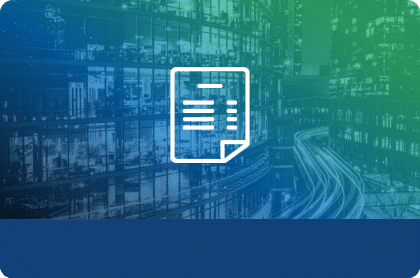ASC 842 Disclosure Requirements for Lessees
Updated 12th May 2021 | 7 min read Published 22nd September 2020

In February 2016, the Financial Accounting Standards Board (“FASB”) issued the new leasing standard in ASU 2016-02 (“ASC 842”) for both lessees and lessors for use when preparing financial statements.
ASC 842 directs that a lessee will recognize right-of-use (“ROU”) assets together with associated lease liabilities on the balance sheet for all lease arrangements with terms longer than 12 months.
In the run-up to the drafting and then publication of ASC 842, much input and feedback were encouraged from potential users and an identified concern was that the existing disclosure requirements did not provide sufficient information for an interested party to fully understand the impact of the leasing activities of a business. With the aim of addressing this, under the new standard, lease disclosures are intended to give financial statement users a better, more transparent understanding of those leasing activities, particularly making it easier for them to “assess the amount, timing, and uncertainty of cash flows arising from leases.”
With this in mind, the standard further indicates that “a lessee [lessor] shall consider the level of detail necessary to satisfy the disclosure objective and how much emphasis to place on each of the various requirements. Following ASC 842-20-50-2 and ASC 842-30-50-2, a “lessee [lessor] shall aggregate or disaggregate disclosures so that useful information is not obscured by either the inclusion of a large amount of insignificant detail or by aggregating items that have different characteristics.”
With their main focus on implementing complete and accurate accounting models for recognition and measurement, too many entities failed to consider disclosures until very late in the transition to ASC 842 compliance. Bearing this lesson in mind to avoid last-minute panics, entities are encouraged to take positive action to fully understand the disclosure requirements early in their implementation process, even making draft qualitative disclosures, and use that knowledge when selecting any solution provider.
An entity will need to make a significant judgment to determine the level of disclosures necessary to satisfy this requirement and as a guiding principle, the basis for conclusions indicates “if leasing is a significant part of an entity’s business activities, the disclosures would be more comprehensive than for an entity whose leasing activities are less significant….” And that may mean that disaggregation might be appropriate.
If not already present in their financial statements as required by other accounting standards, entities must make appropriate disclosures regarding the adoption of ASC 842 for each annual reporting period for which a statement of comprehensive income (statement of activities) is presented and in each year-end financial statement. Public Companies should note that the Securities and Exchange Commission (SEC) requires them in the year of ASC 842 adoption to include all required annual disclosures in any interim financial statements that are prepared until the next annual financial statements are filed – even if the disclosure requirements are only applicable for annual periods.
Key disclosure requirements for lessees:
1. Statement of Financial Position: ASC 842-20-45-1 through 45-3
- Present, or disclose in the notes, separately from each other and from other assets and liabilities:
-
-
- Finance lease right-of-use assets
- Operating lease right-of-use assets
- Finance lease liabilities
- Operating lease liabilities
-
- Classify right-of-use assets and lease liabilities as current or non-current consistent with the way similar non-financial assets and financial liabilities are classified
- Disclose which line items in the statement of financial position include the right-of-use assets and lease liabilities
- Do not present in the same line item the right of use asset and associated liabilities of operating leases with the right of use asset and associated liabilities of finance leases
2. Statement of Comprehensive Income: ASC 842-20-45-4
- For finance leases, present interest expense on the lease liability and amortization of the right-of-use asset in a manner consistent with how the entity presents other interest expense and depreciation and amortization of similar assets, respectively
- For operating leases, lease expense should be included in income from continuing operations
3. Statement of Cash Flows: ASC 842-20-45-5
- Classify repayments of the principal portion of the lease liability arising from finance leases within financing activities
- Classify interest on the lease liability arising from finance leases in accordance with requirements relating to interest paid in ASC 230 on cash flows
- Classify those payments arising from operating leases within operating activities, except to the extent that those payments represent costs to bring another asset to the condition and location necessary for its intended use, which should be classified within investing activities
- Classify any variable lease payments and short-term lease payments not included in the lease liability within operating activities
4. Significant Judgments: ASC 842-20-50-3(c)
Information about significant assumptions and judgments made, including:
- The determination of whether a contract contains a lease
- The allocation of consideration in a contract between lease and non-lease components
- The determination of the discount rate for the lease
5. Quantitative Disclosures: ASC 842-20-50-4 and 50-6
For each period presented, disclose amounts related to a lessee’s total lease cost (including both amounts recognized in income and capitalized) and the cash flows arising from lease transactions.
- Finance lease costs, segregated between:
- Amortization of right-of-use assets and
- Interest on lease liabilities
- Operating lease costs
- Short-term lease cost excluding those expenses relating to leases with a lease term of one month or less
- Variable lease costs
- Sublease income, disclosed on a gross basis, separate from finance or operating lease expense
- Net gain or loss recognized from sale and leaseback transactions
- Amounts segregated between those for finance and operating leases for:
- Cash paid for amounts included in the measurement of lease liabilities segregated between operating and financing cash flows
- Supplemental non-cash information lease liabilities arising from obtaining right-of-use assets
- Weighted-average remaining lease term
- Weighted-average discount rate
Finally, for quantitative disclosures disclose a maturity analysis of undiscounted lease liabilities (i.e. 5-year table) separately for finance leases and operating leases and provide a reconciliation of undiscounted cash flows to the finance lease liabilities and operating lease liabilities recognized in the statement of financial position.
6. Policy Elections and Practical Expedients: ASC 842-20-50-8 through 50-9
- Disclose policy election for short-term leases, and if elected the short-term lease expense does not reasonably reflect the lessee’s short-term lease commitments, disclose that fact and the number of short-term lease commitments
- Disclose practical expedient for not separating lease components from non-lease components, if elected the class or classes of underlying assets to which the election applies
How lease accounting software can help improve the efficiency and accuracy of disclosures
The process of bringing leases on to the balance sheet significantly increases the disclosure requirements for lessees as well as impacting an organisation’s financial statements. Further data gathering and collation is also necessary under the new standard.
Once the requisite data had been found and collated, additional work is often necessary to validate the accuracy of the information and perform the relevant calculations. This can be a time-intensive and erroneous exercise if performed without the assistance of lease accounting software. Furthermore, these calculations need to be updated on an ongoing basis whenever lease modifications or changes take place.
To minimize risks and to help ensure the integrity of an organizations financial statements are maintained and to help improve the accuracy of quantitative disclosures, lessees are encouraged to consider lease accounting software capable of generating the requisite accounting calculations, disclosures, and reports in line with the new standard.
Summary
In conclusion, when considering the issue of disclosures, consider them early in the process and give them the necessary “airtime” to avoid the last-minute panic of addressing them. In relation to the adoption of ASC 842 ensure that:
- disclosure requirements are part of the technology selection process
- there is due consideration of the materiality of disclosures
- all material and significant assumptions and judgements are documented
- disclosures apply to all leases and not just those reported on the balance sheet
- pre-adoption disclosures for public companies are disclosed
- any practical expedients taken are disclosed
- lease transactions with related parties are reported
- the election or otherwise to restate comparative periods is explained
- disclosures are provided for any sale and leaseback together with
- main terms and conditions of the transactions
- and separately from those on disposal of other assets, any gains or losses resulting from the sale
Suitable lease accounting software will help when companies prepare, perform and generate their lease disclosures, whilst also improving the efficiency and accuracy of the information that is disclosed.
To find out how lease accounting software can help fast-track your lease accounting project request a free demo and consultation today.
Disclaimer: this article contains general information about the new lease accounting standards only and should NOT be viewed in any way as professional advice or service. The Publisher will not be responsible for any losses or damages of any kind incurred by the reader whether directly or indirectly arising from the use of the information found within this article.



